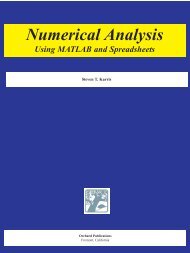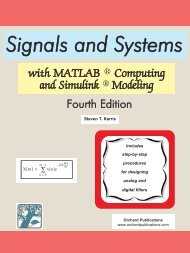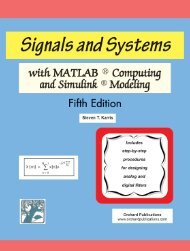COMPUTING
Second Edition - Orchard Publications
Second Edition - Orchard Publications
- No tags were found...
Create successful ePaper yourself
Turn your PDF publications into a flip-book with our unique Google optimized e-Paper software.
The Silicon Controlled Rectifier (SCR)amplifier which takes reference and system feedback inputs and computes the amount of error(difference) between the actual output voltage and the desired setpoint value. Even though theSCR is an analog device, many new control systems now use a microprocessor based, digital, firingcircuit to sense the AC line zero−crossing, measure feedback and compare it with the setpoint,and generate the required firing angle to hold the system in a balanced state.Another consideration is SCR protection. The SCR, like a conventional diode, has a very highone−cycle surge rating. Typically, the device will carry from eight to ten time its continuous currentrating for a period of one electrical cycle. It is extremely important that the proper high−speed, current−limiting, rectifier fuses recommended by the manufacturer be employed; oneshould never substitute with another type fuse. Current limiting fuses are designed to sense a faultin a quarter−cycle and clear the fault in one−half of a cycle, thereby protecting the SCR from damagedue to short circuits.Switching spikes and transients, which may exceed the device PIV rating, are also a serious concernwith semiconductor devices. Surge suppressors, such as the GE Metal−Oxide−Varistor(MOV), are extremely effective in absorbing these short−term transients. High voltage capacitorsare also often employed as a means of absorbing these destructive spikes and provide a degree ofelectrical noise suppression as well.4.7.1 The SCR as an Electronic SwitchThe SCR circuit of Figure 4.27 shows a possible arrangement for switching the SCR to the offposition. We recall that to switch the SCR to the off position, the anode to cathode voltage mustbe zero or negative.v inR 1CR 4v C SV SFigure 4.27. A switching circuit using an SCRThe SCR in the circuit of Figure 4.27 is switched to the on (conducting) state by applying a positivetriggering pulse at v inand with the SCR on, there is there is a very small voltage drop fromanode to cathode. The capacitor then charges to voltage v C and this voltage is approximatelyequal to V S . The SCR will be turned off by closing the switch S , and when this occurs, we observethat the positive side of the capacitor is connected to the ground. Since the capacitor voltage cannotchange instantly, the anode of the SCR becomes negative with respect to the cathode. TheElectronic Devices and Amplifier Circuits with MATLAB Computing, Second EditionCopyright © Orchard Publications4−27







